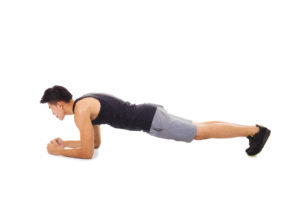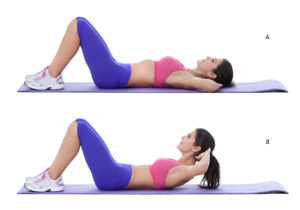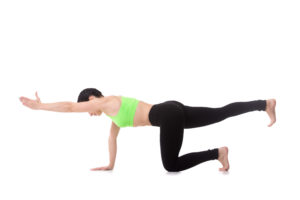Strong core muscles are important in supporting and stabilizing the spine. When we think of our core, we often think of our abdominals, or six-pack region. While the abdominals are a significant part of the core strength, there are other muscles that are important as well. These include:
- Back extensor muscles- anatomically known as erector spinae or spinal erectors, these muscles start at the base of the skull and run all the way down to the tailbone.
- Obliques – the muscles along the side of your body.
- Traverse abdominis – a muscle layer of the front and side abdominal wall which is layered below the internal oblique muscle.
If you have weak core and lower back muscles, your body will rely more on other structures for stability, such as ligaments (the connective tissues between bones), the spinal bones and discs, which lie between the spinal bones. When these more delicate structures are put under strain, it can cause back pain. This is why having a strong core is important for enabling safe movements such as bending, twisting, and turning.
Here are some exercises you can do at home (no special equipment required) to help strengthen your core muscles and prevent back
pain:
 Planks – There are many variations and modifications of planks including front and side planks, all of which help tone the erector or back extensor muscles. These should be combined with abdominal exercises to increase the strength of the internal and external oblique muscles. Consider performing three sets of five reps of each with five-second hold time.
Planks – There are many variations and modifications of planks including front and side planks, all of which help tone the erector or back extensor muscles. These should be combined with abdominal exercises to increase the strength of the internal and external oblique muscles. Consider performing three sets of five reps of each with five-second hold time.
 Partial crunches – proper form is very important in performing this exercise to prevent excessive stress on your neck and lower back. Start by lying on your back with knees bent and feet flat on the floor. Cross arms over your chest or put hands behind your neck. Tighten you stomach muscles to raise your shoulders off the floor, hold for a second and then slowly lower yourself back down. Do not pull yourself up by leading with your elbows or use arms to pull your neck off the floor. Also, be sure that your feet, tailbone, and lower back remain in contact with the floor at all times.
Partial crunches – proper form is very important in performing this exercise to prevent excessive stress on your neck and lower back. Start by lying on your back with knees bent and feet flat on the floor. Cross arms over your chest or put hands behind your neck. Tighten you stomach muscles to raise your shoulders off the floor, hold for a second and then slowly lower yourself back down. Do not pull yourself up by leading with your elbows or use arms to pull your neck off the floor. Also, be sure that your feet, tailbone, and lower back remain in contact with the floor at all times.
 Bird Dog – Start on your hands and knees in a table position and tighten your stomach muscles. Lift and extend one leg behind you while keeping your hips level. Hold for five seconds, and then switch to the other leg. Once you have mastered this, try lifting and extending your opposite arm with your leg for each repetition. Make sure that while doing this exercise you only raise your arms and legs to heights that maintain a flat back position. This exercise is a great for improving balance and learning how to stabilize the low back during movement of the arms and legs.
Bird Dog – Start on your hands and knees in a table position and tighten your stomach muscles. Lift and extend one leg behind you while keeping your hips level. Hold for five seconds, and then switch to the other leg. Once you have mastered this, try lifting and extending your opposite arm with your leg for each repetition. Make sure that while doing this exercise you only raise your arms and legs to heights that maintain a flat back position. This exercise is a great for improving balance and learning how to stabilize the low back during movement of the arms and legs.
A great way to incorporate additional support is by using a big exercise ball. You can also try yoga which features many core stability and strengthening exercises. However, always remember to check with your healthcare provider before beginning any new exercise plan.
David J. BenEliyahu, DC, DAAPM, DABCSP is the Administrative Director of the Back & Neck Pain Center at Mather Hospital.
Attend a free seminar on the prevention and treatment of back and neck pain.

